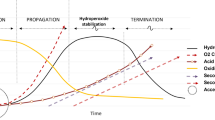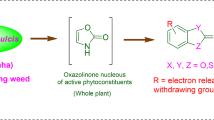Abstract
A series of bis-benzodioxole derivatives was designed, synthesized, and evaluated. These target compounds were designed through structure simplification and ester bond flip**. The lipid-lowering activity of these target compounds was preliminarily evaluated in a hyperlipidemic mouse model induced by Triton WR 1339. The results showed that piperonylic acid -6-(3,4-methylenedioxyphenoxy) hexyl ester (T5) possesses notable lipid-lowering properties, reducing triglyceride (TG) and total cholesterol (TC) levels. The dose-dependent study revealed that compound T5 decreased TG and TC more strongly with the increase of dose. It was observed that T5 had considerable effects on decreasing TG, TC and low density lipoprotein cholesterol (LDL-C) levels in hyperlipidemic mice induced by high fat diet (HFD). Meanwhile, T5 was found to have hepatoprotective activity, with the liver aspartate transaminase (AST) and alanine aminotransferase (ALT) significantly decreasing and histopathological observation showing that it inhibited lipids accumulation in the liver and alleviated liver injury. T5 has been shown to stimulate peroxisome proliferator-activated receptor-α (PPAR-α) and suppress hydroxymethylglutaryl coenzyme A (HMG-CoA) reductase in the liver in connection to lipid metabolism. The molecular docking study also revealed that T5 has a high affinity for the active sites of PPAR-α and HMG-CoA reductase. Furthermore, other beneficial activities, including antioxidation and anti-inflammation, were also noted. It is possible that further exploration may result in compound T5 becoming a promising candidate for lipid-lowering therapy.


















Similar content being viewed by others
References
Pastuszak Z, Kozniewska E, Stepien A, Piusinska-Macoch A, Czernicki Z, Koszewski W. Importance rating of risk factors of ischemic stroke in patients over 85 years old in the polish population. Neurol Neurochir Pol. 2018;52:88–93. https://doi.org/10.1016/j.pjnns.2017.11.007.
Navar-Boggan AM, Peterson ED, D’Agostino RB, Neely B, Sniderman AD, Pencina MJ. Hyperlipidemia in Early Adulthood Increases Long-Term Risk of Coronary Heart Disease. Circulation. 2015;131:451–8. https://doi.org/10.1161/CIRCULATIONAHA.114.012477.
Chevli PA, Freedman BI, Hsu FC, Xu JZ, Rudock ME, Ma LJ, et al. Plasma metabolomic profiling in subclinical atherosclerosis: the Diabetes Heart Study. Cardiovasc Diabetol. 2021;20:215. https://doi.org/10.1186/s12933-021-01419-y.
Nomura S, Takahashi N, Inami N, Kajiura T, Yamada K, Nakamori H, et al. Probucol and ticlopidine: effect on platelet and monocyte activation markers in hyperlipidemic patients with and without type 2 diabetes. Atherosclerosis. 2004;174:329–35. https://doi.org/10.1016/j.atherosclerosis.2004.01.027.
Zhang YP, Wang YX, Zhou JQ, Wang Q, Yan YN, Yang X, et al. The Influence of Diabetes, Hypertension, and Hyperlipidemia on the Onset of Age-Related Macular Degeneration in North China: The Kailuan Eye Study. Biomed Environ Sci. 2022;35:613–21. https://doi.org/10.3967/bes2022.081.
Kim E, Yang JW, Park KW, Cho SH. Preventative, but not post-stroke, inhibition of CD36 attenuates brain swelling in hyperlipidemic stroke. J Cereb Blood Flow Metab. 2020;40:885–94. https://doi.org/10.1177/0271678X19850004.
Sahebkar A, Simental-Mendía LE, Watts GF, Serban MC, Banach M, Lipid Blood Pressure M-A. Comparison of the effects of fibrates versus statins on plasma lipoprotein(a) concentrations: a systematic review and meta-analysis of head-to-head randomized controlled trials. BMC Med. 2017;15:22. https://doi.org/10.1186/s12916-017-0787-7.
Thompson PD, Panza G, Zaleski A, Taylor B. Statin-Associated Side Effects. J Am Coll Cardiol. 2016;67:2395–410. https://doi.org/10.1016/j.jacc.2016.02.071.
Barkas F, Adamidis P, Koutsogianni A-D, Liamis G, Liberopoulos E. Statin-associated side effects in patients attending a lipid clinic: evidence from a 6-year study. Arch Med Sci Atheroscler Dis. 2021;6:e182–e187. https://doi.org/10.5114/amsad.2021.111313.
Demyen M, Alkhalloufi K, Pyrsopoulos NT. Lipid-Lowering Agents and Hepatotoxicity. Clin Liver Dis. 2013;17:699–714. https://doi.org/10.1016/j.cld.2013.07.016.
Liu HT, Zhang PP, Ge XX, Wu Q, Han CC, Zhang LY, et al. Optimization of clofibrate with O-desmethyl anetholtrithione lead to a novel hypolipidemia compound with hepatoprotective effect. Bioorg Med Chem Lett. 2022;72:128844 https://doi.org/10.1016/j.bmcl.2022.128844.
Hedrington MS, Davis SN. Peroxisome proliferator-activated receptor alpha-mediated drug toxicity in the liver. Expert Opin Drug Metab Toxicol. 2018;14:671–7. https://doi.org/10.1080/17425255.2018.1483337.
Guo ZR. The modification of natural products for medical use. ACTA Pharm Sin B. 2017;7:119–36. https://doi.org/10.1016/j.apsb.2016.06.003.
Najmi A, Javed SA, Al Bratty M, Alhazmi HA. Modern Approaches in the Discovery and Development of Plant-Based Natural Products and Their Analogues as Potential Therapeutic Agents. Molecules. 2022;27:349. https://doi.org/10.3390/molecules27020349.
Narasimhulu CA, Selvarajan K, Litvinov D, Parthasarathy S. Anti-Atherosclerotic and Anti-Inflammatory Actions of Sesame Oil. J Med Food. 2015;18:11–20. https://doi.org/10.1089/jmf.2014.0138.
Zhang RJ, Yu Y, Hu SK, Zhang JH, Yang HX, Han B, et al. Sesamin ameliorates hepatic steatosis and inflammation in rats on a high-fat diet via LXRα and PPARα. Nutr Res. 2016;36:1022–30. https://doi.org/10.1016/j.nutres.2016.06.015.
**e Y, Liu J, Shi Y, Wang B, Wang X, Wang W, et al. Structural simplification and bioisostere principle lead to Bis-benzodioxole-fibrate derivatives as potential hypolipidemic and hepatoprotective agents. Bioorg Chem. 2021;117:105454. https://doi.org/10.1016/j.bioorg.2021.105454.
Garg G, Patil A, Singh J, Kaushik N, Praksah A, Pal A, et al. Pharmacological evaluation of Convolvulus pluricaulis as hypolipidaemic agent in Triton WR-1339-induced hyperlipidaemia in rats. J Pharm Pharmacol. 2018;70:1572–80. https://doi.org/10.1111/jphp.13004.
Bouhlali EDT, Hmidani A, Bourkhis B, Khouya T, Harnafi H, Filali-Zegzouti Y, et al. Effect of Phoenix dactylifera seeds (dates) extract in triton WR-1339 and high fat diet induced hyperlipidaemia in rats: A comparison with simvastatin. J Ethnopharmacol. 2020;259:112961. https://doi.org/10.1016/j.jep.2020.112961.
Todisco S, Santarsiero A, Convertini P, De Stefano G, Gilio M, Iacobazzi V, et al. PPAR Alpha as a Metabolic Modulator of the Liver: Role in the Pathogenesis of Nonalcoholic Steatohepatitis (NASH). Biol Basel. 2022;11:792. https://doi.org/10.3390/biology11050792.
Wang H, Sun ZO, Ur-Rehman R, Riaz S, Shen TT, Fan ZC, et al. Apple phlorizin reduce plasma cholesterol by down-regulating hepatic HMG-CoA reductase and enhancing the excretion of fecal sterols. J Funct Foods. 2019;62:103548. https://doi.org/10.1016/j.jff.2019.103548.
Yang RL, Shi YH, Hao G, Li W, Le GW. Increasing Oxidative Stress with Progressive Hyperlipidemia in Human: Relation between Malondialdehyde and Atherogenic Index. J Clin Biochem Nutr. 2008;43:154–8. https://doi.org/10.3164/jcbn.2008044.
He DQ, Zhang JW, Chen YQ, Li ZL. Tanshinone IIA Alleviates Atherosclerosis Through Inhibition of NF-κB and PPARαE/ABCA1 Signaling Pathways. J Biomed Nanotechnol. 2023;19:1824–31. https://doi.org/10.1166/jbn.2023.3689.
Kuo DH, Yeh CH, Shieh PC, Cheng KC, Chen FA, Cheng JT. Effect of ShanZha, a Chinese herbal product, on obesity and dyslipidemia in hamsters receiving high-fat diet. J Ethnopharmacol. 2009;124:544–50. https://doi.org/10.1016/j.jep.2009.05.005.
Song KH, Lee SH, Kim BY, Park AY, Kim JY. Extracts of Scutellaria baicalensis Reduced Body Weight and Blood Triglyceride in db/db Mice. Phytother Res. 2013;27:244–50. https://doi.org/10.1002/ptr.4691.
Chang ST, Chu CM, Hsu TE, Pan KL, Lin PG, Chung CM. Role of ankle-brachial pressure index as a predictor of coronary artery disease severity in patients with diabetes mellitus. Can J Cardiol. 2009;25:E301–E305. https://doi.org/10.1016/S0828-282X(09)70140-0.
Alvarez-Jimenez L, Moreno-Cabañas A, Ramirez-Jimenez M, Morales-Palomo F, Ortega JF, Mora-Rodriguez R. Effectiveness of statins vs. exercise on reducing postprandial hypertriglyceridemia in dyslipidemic population: A systematic review and network meta-analysis. J Sport Health Sci. 2022;11:567–77. https://doi.org/10.1016/j.jshs.2021.07.006.
Higashi K, Shige H, Ito T, Nakajima K, Ishikawa T, Nakamura H, et al. Impaired glucose tolerance without hypertriglyceridemia does not enhance postprandial lipemia. Horm Metab Res. 2001;33:101–5. https://doi.org/10.1055/s-2001-12400.
Zhang YW, Xu K, Zhang YQ. Ginsenoside-Mc1 reduces ischemia/reperfusion-induced cardiac arrhythmias through activating JAK2/STAT3 pathway and attenuating oxidative/endoplasmic reticulum stress in hyperlipidemic rats. Turkish J Biochem Turk Biyokimya Derg. 2022;47:491–500. https://doi.org/10.1515/tjb-2021-0171.
Amrita J, Mahajan M, Bhanwer AJS, Mohan G. Oxidative Stress: An Effective Prognostic Tool for an Early Detection of Cardiovascular Disease in Menopausal Women. Biochem Res Int. 2016;2016:6157605–6157605. https://doi.org/10.1155/2016/6157605.
Farah R, Jubran F, Khamisy-Farah R. Effects of statins on oxidative stress and primed polymorphonuclear leukocytes in hyperlipidemic patients. Biotech Histochem. 2012;87:519–25. https://doi.org/10.3109/10520295.2012.719243.
Shen YC, Yang T, Guo SJ, Li XO, Chen L, Wang T, et al. Increased Serum ox-LDL Levels Correlated with Lung Function, Inflammation, and Oxidative Stress in COPD. Mediat Inflam. 2013;2013. https://doi.org/10.1155/2013/972347.
Teppner M, Böss F, Ernst B, Pähler A. Application of lipid peroxidation products as biomarkers for flutamide-induced oxidative stress in vitro. Toxicol Lett. 2015;238:53–59. https://doi.org/10.1016/j.toxlet.2015.08.005.
Hasanein P, Ghafari-Vahed M, Khodadadi I. Effects of isoquinoline alkaloid berberine on lipid peroxidation, antioxidant defense system, and liver damage induced by lead acetate in rats. Redox Rep. 2017;22:42–50. https://doi.org/10.1080/13510002.2016.1140406.
Ratheesh M, Svenia JP, Asha S, Sandya S, Girishkumar B, Krishnakumar IM. Anti-inflammatory effect of a novel formulation of coconut inflorescence sap against ox-LDL induced inflammatory responses in human peripheral blood mononuclear cells by modulating TLR-NF-κB signaling pathway. Toxicol Mech Methods. 2017;27:615–21. https://doi.org/10.1080/15376516.2017.1344339.
Chen S, Sun LX, Zhang JJ, Zhang L, Liu X. Oxygenized Low-Density Lipoprotein-Induced ASMC Dysregulation Depends on circ_0000345-Mediated Regulatory Mechanism. J Atheroscler Thromb. 2022;29:1849–63. https://doi.org/10.5551/jat.63327.
Li DY, Liu L, Chen HJ, Sawamura T, Mehta JL. LOX-1, an oxidized LDL endothelial receptor, induces CD40/CD40L signaling in human coronary artery endothelial cells. Arterioscler Thromb Vasc Biol. 2003;23:816–21. https://doi.org/10.1161/01.ATV.0000066685.13434.FA.
Krakauer T. Inflammasome, mTORC1 activation, and metabolic derangement contribute to the susceptibility of diabetics to infections. Med Hypotheses. 2015;85:997–1001. https://doi.org/10.1016/j.mehy.2015.08.019.
Lalloyer F, Wouters K, Baron M, Caron S, Vallez E, Vanhoutte J, et al. Peroxisome Proliferator-Activated Receptor-α Gene Level Differently Affects Lipid Metabolism and Inflammation in Apolipoprotein E2 Knock-In Mice. Arterioscler Thromb Vasc Biol. 2011;31:1573–U1198. https://doi.org/10.1161/ATVBAHA.110.220525.
Paumelle R, Blanquart C, Briand O, Barbier O, Duhem C, Woerly G, et al. Acute antiinflammatory properties of statins involve peroxisome proliferator-activated receptor-α via inhibition of the protein kinase C signaling pathway. Circ Res. 2006;98:361–9. https://doi.org/10.1161/01.RES.0000202706.70992.95.
Lin HC, Lii CK, Lin AH, Li CC, Tsai CH, Pan SK, et al. Docosahexaenoic acid inhibits TNFα-induced ICAM-1 expression by activating PPARα and autophagy in human endothelial cells. Food Chem Toxicol. 2019;134:110811. https://doi.org/10.1016/j.fct.2019.110811.
Yu J, Ip E, dela Peña A, Hou JY, Sesha J, Pera N, et al. COX-2 induction in mice with experimental nutritional steatohepatitis: Role as pro-inflammatory mediator. Hepatology. 2006;43:826–36. https://doi.org/10.1002/hep.21108.
Lee SH, Chung IM, Cha YS, Park Y. Millet consumption decreased serum concentration of triglyceride and C-reactive protein but not oxidative status in hyperlipidemic rats. Nutr Res. 2010;30:290–6. https://doi.org/10.1016/j.nutres.2010.04.007.
Zheng WY, Song ZY, Li S, Hu MM, Shaukat H, Qin H. Protective Effects of Sesamol against Liver Oxidative Stress and Inflammation in High-Fat Diet-Induced Hepatic Steatosis. Nutrients. 2021;13:4484 https://doi.org/10.3390/nu13124484.
Fu K, Zhou HL, Wang C, Gong LH, Ma C, Zhang YF, et al. A review: Pharmacology and pharmacokinetics of Schisandrin A. Phytother Res. 2022;36:2375–93. https://doi.org/10.1002/ptr.7456.
Saberi SEM, Chua LS. Potential of rosmarinic acid from Orthosiphon aristatus extract for inflammatory induced diseases and its mechanisms of action. Life Sci. 2023;333:122170 https://doi.org/10.1016/j.lfs.2023.122170.
Dong YH, Zhang JJ, Gao Z, Zhao HJ, Sun GY, Wang XX, et al. Characterization and anti-hyperlipidemia effects of enzymatic residue polysaccharides from Pleurotus ostreatus. Int J Biol Macromol. 2019;129:316–25. https://doi.org/10.1016/j.ijbiomac.2019.01.164.
Mittal G, Chandraiah G, Ramarao P, Kumar M. Pharmacodynamic Evaluation of Oral Estradiol Nanoparticles in Estrogen Deficient (Ovariectomized) High-Fat Diet Induced Hyperlipidemic Rat Model. Pharm Res. 2009;26:218–23. https://doi.org/10.1007/s11095-008-9725-x.
**e YD, Liu JP, Shi YH, Bin W, Wang XP, Wang W, et al. Synthesis and evaluation of new sesamol-based phenolic acid derivatives with hypolipidemic, antioxidant, and hepatoprotective effects. Med Chem Res. 2021;30:1688–702. https://doi.org/10.1007/s00044-021-02770-1.
**e YD, Liu JP, Shi YH, Wang B, Wang XP, Wang W, et al. The combination of sesamol and clofibric acid moieties leads to a novel potent hypolipidemic agent with antioxidant, anti-inflammatory and hepatoprotective activity. Bioorg Med Chem Lett. 2021;44:128121. https://doi.org/10.1016/j.bmcl.2021.128121.
**e YD, Xu YH, Liu JP, Wang B, Shi YH, Wang W, et al. 1,3-Benzodioxole-based fibrate derivatives as potential hypolipidemic and hepatoprotective agents. Bioorg Med Chem Lett. 2021;43:127898 https://doi.org/10.1016/j.bmcl.2021.127898.
Acknowledgements
This study was supported by Shaanxi University of Traditional Chinese Medicine Student Innovation and Entrepreneurship Training Program Project (No 202210716107). Shaanxi Province key research and development plan project (No. 2024SF-YBXM-487). Sci-Tech Innovation Talent System Construction Program of Shaanxi University of Chinese Medicine (No. 2023-CXTD-05). Shaanxi Special Support Plan Talent Project. Shaanxi Provincial Administration of Traditional Chinese Medicine “Double Chain Integration” Young and middle-aged Scientific Research and Innovation Team Project (2022-SLRH-YQ-008).
Author information
Authors and Affiliations
Corresponding authors
Ethics declarations
Conflict of interest
The authors declare no competing interests.
Additional information
Publisher’s note Springer Nature remains neutral with regard to jurisdictional claims in published maps and institutional affiliations.
Supplementary information
Rights and permissions
Springer Nature or its licensor (e.g. a society or other partner) holds exclusive rights to this article under a publishing agreement with the author(s) or other rightsholder(s); author self-archiving of the accepted manuscript version of this article is solely governed by the terms of such publishing agreement and applicable law.
Received:
Accepted:
Published:
Issue Date:
DOI: https://doi.org/10.1007/s00044-024-03216-0




